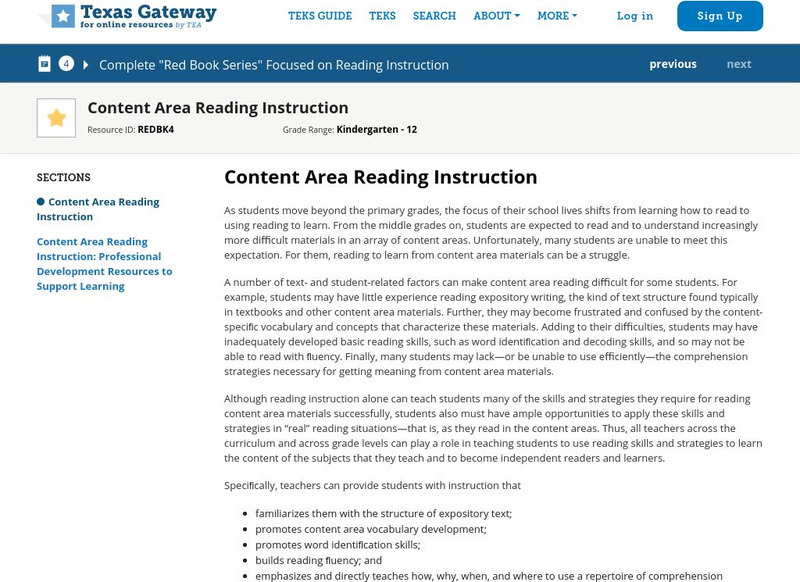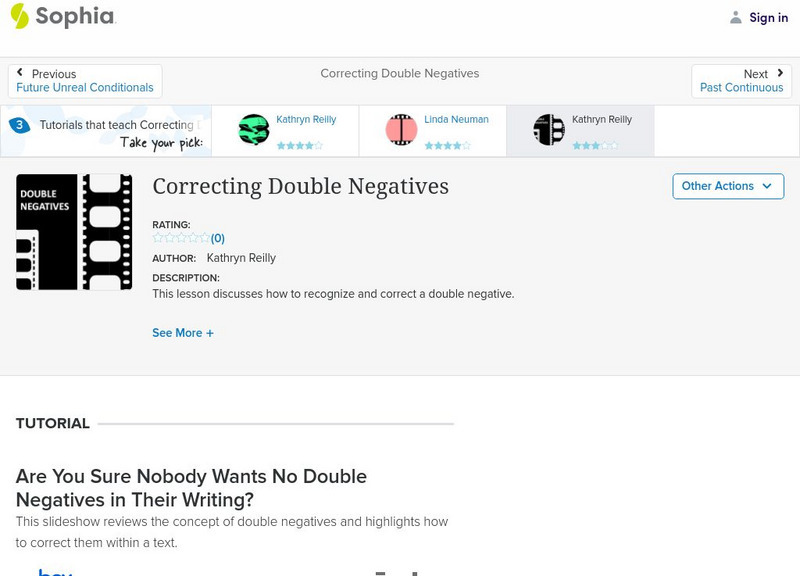Department of Defense
Do Dea: Conventions
Sharpen your use of the formal conventions of English with this self-guided learning module. The module focuses on formal and informal language, making pronouns agree with their antecedents, and common spelling and grammar errors. At the...
Texas Education Agency
Texas Gateway: Reading Instruction: Content Area Reading Instruction
This website offers a free download of the Research-Based Content Area Reading Instruction booklet. The purpose of this booklet is to provide teachers with research-based and classroom-tested information about each of these aspects of...
CPALMS
Cpalms: Calling All Kid Presidents
[Free Registration/Login Required] In this lesson, students will watch a video of Kid President giving a speech and another of a student's winning speech to be vice-president of the student council. They will also read an excerpt from...
BBC
Bbc Bitesize: Speaking and Listening: Standard English
Explains what standard English is and when it is used, the difference between formal and informal language, and non-standard forms of English such as those found in dialects.
Grammarly
Grammarly Blog: Capitalization:titles of Books, Articles, Songs
This page explains the rules for capitalizing titles: In informal writing all words may be capitalized, but in formal writing, articles, conjunctions, and prepositions are NOT capitalized unless they begin a sentence. Examples are provided.
New Zealand Ministry of Education
Nz Ministry of Education: Listen Up! Speak Up!
In this instructional activity students are given provided many opportunities to practice both informal and formal speaking skills. They begin with informal speaking in pairs, then groups of 4, etc. Then they write several drafts of a...
Sophia Learning
Sophia: Appropriate Language
This lesson focuses on using appropriate language in formal writing; it discusses pretentious language, jargon, and cliches. It defines each, provides examples, and explains why and how to avoid each. SL.9-10.6 Adapt to task/formal
Khan Academy
Khan Academy: Style and Technique
Use context to figure out how to use language appropriately--formality, irony, understatement, and overstatement.
Lumen Learning
Lumen: Boundless Communications: Introduction
In this section of a textbook, students learn different techniques for writing an introduction. It provides links to information on the following topics: the role of an introduction, getting attention and interest, establishing...
Sophia Learning
Sophia: Correcting Double Negatives
This slideshow lesson focuses on fixing double negatives. It starts by showing what a double negative really says and how to make it say what they mean. It discusses why they are not used, when they can be used in writing, a list of...
Sophia Learning
Sophia: Correcting Double Negatives
This slideshow lesson focuses on double negatives. It includes defining the term, explaining why they aren't used, providing a list of "no" words, offering ways to correct them with examples, and listing steps to eliminate them in writing.
Online Writing Lab at Purdue University
Purdue University Owl: Using Appropriate Language
Knowing the right language for your particular audience is a necessary skill for all writers. No one wants to offend their audience or appear as though they don't know their content. Learn these rules of thumb to become more familiar...
AdLit
Ad lit.org: Engaging Family & Community in Afterschool and Summer Programs
Informal literacy experiences often serve to shape young people's identity as readers and writers as much as or more than formal schooling.Community and family support can emphasize the importance of reading and writing, build...
CK-12 Foundation
Ck 12: 7.1: Tone and Style
[Free Registration/Login may be required to access all resource tools.] Gain a better understanding of tone and style by understanding formal and informal style, learning to write clearly, correcting vague sentences, distinguishing...
Cambridge Rindge & Latin School
Cambridge Rindge & Latin School: Making an Outline
A tip sheet on how to create and outline for a research paper.
















